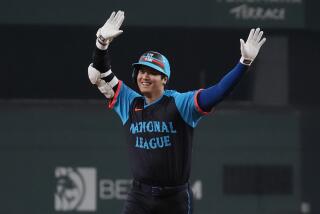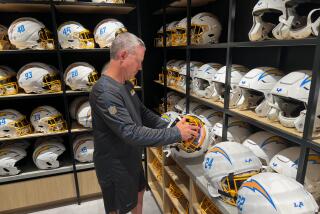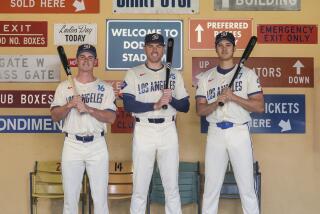Gearing for the Future : Fashion: High-tech fabrics are moving onto the football field. But it may be a while before the uniforms are designed with a little more flash.
Football uniforms, like sports socks, tend to be conservative when it comes to color and design. But for a game like the Jan. 28 Super Bowl, with a projected worldwide viewing audience of more than 125 million, including half the men and a third of the women in the United States, you would think somebody could come up with something more interesting for the players to wear. Uniforms with some snap--gladiatorial, employing fashion design tricks to make the players look taller, faster, broader and more menacing.
It isn’t likely to happen any time soon.
David Boss, vice president and creative director of NFL Properties, the merchandising arm of the National Football League, contends that if the coaches had their way, all players would wear solid colored jerseys and white pants. That would be the most unobtrusive combination for coaches trying to spot their own players on the field. Busy patterns and multiple colors make it too confusing, coaches say.
Yet, there is at least one visionary within the ranks. Merv Corning, who has been working as an artist for the NFL since 1967, illustrating product catalogues and painting the annual portrait of the NFL’s Player of the Year, envisions a uniform that employs electronic gadgetry, malleable plastics and one-piece construction.
He sees radio receivers and head phones installed in helmets for better on-field communications between players. On Corning’s futuristic helmet, the side has been cut back from the temple to provide more peripheral vision and a visor with a gradated lens has been attached to lessen the glare from stadium lights and the sun.
He suggests inflatable protection pads and hinged plastic braces for knees and elbows; he estimates they would weigh one-third what traditional metal-heavy equipment weighs.
Corning even designed a one-piece, zipper-front uniform (flying shirttails are too easy for the competition to grab), with built-in, battery-operated heating and cooling units. But he is pragmatic about the slim chances of ever seeing his ideas come to fruition. “Sports people as a whole are oblivious to the finer points,” he laments.
If they ever do occur, uniform manufacturers predict changes in NFL fashions will develop in much the same way they did for the National Basketball Assn.--as a byproduct of the addition of new teams to the league.
Some recent start-up teams in the NBA have set new standards in unconventional uniform style. There are the teal-colored, pin-striped uniforms with pleated trunks that ready-to-wear designer Alexander Julian came up with for the Charlotte Hornets, and the black and white, pin-striped uniforms with long, Bermuda-length trunks advertising designer Doug Minear created for the Orlando Magic. Meanwhile, the sports world awaits the uniforms that track star Florence Griffith Joyner designed for the Indiana Pacers. They are scheduled for unveiling later this month.
In the face of this innovation, some longstanding NBA teams are clamoring for changes, says Peter Knutson, a marketing director for MacGregor Sand-Knit, a company that manufacturers football and basketball uniforms. And with the proposed expansion of the NFL, Knutson predicts that changes for football uniforms are only a franchise away.
“All it takes is a couple of rebels to come from the outside and changes start to happen,” he said.
Boss of NFL Properties, who has had numerous uniforms shot down, takes a more cautious view.
In 1964, the Cleveland Browns went looking for an emblem to put on their orange helmets. The NFL provided them with a CB monogram. According to Boss, it was quarterback Frank Ryan who objected, claiming the identity of the team was blue-collar and they didn’t need “any Mickey Mouse stuff” on their helmets. To this day the Cleveland Browns don’t have any identification on their jerseys or helmets.
The Browns weren’t the only team that rejected new designs. The Denver Broncos, the New England Patriots, the San Francisco 49ers and the Tampa Bay Buccaneers have all nixed changes.
And Boss’ design last year for a new Pro Bowl jersey was turned down flat. “They absolutely hated it,” recalls Boss. To the unenlightened, Boss’ bright red, white and blue jersey with bars and stars might have looked like regulation issue football gear. Apparently those in the know were more sensitive to what Boss called a “little departure.”
Any number of well-meaning fans have encountered the same sensitivity. Last year Todd Asselin, a Kansas City Chiefs enthusiast, contributed a new helmet design to the Chiefs, one painted to look like an Indian war bonnet. It was quite colorful and eye-catching as NBC flashed it across the television screen during one of the Chiefs games. But that split-second preview was as close as Asselin’s design got to the playing field.
But major changes are likely be only in response to safety innovations or advances in fabric technology. In the last three years, many teams have started wearing pants made of an Antron fiber, not only because the bright and shiny fabric is wonderfully photogenic, but because the fiber can be elasticized to make the pants fit so tight that there is no extra material for an opposing player to grab.
There are other examples of how high-tech fabrics are affecting the construction, if not the silhouette, of uniforms. Pants are often made with one material in the front that is heavy and durable to withstand the abrasion of artificial turf and a more elasticized, lightweight fabric in the back to provide the second-skin tightness that is preferred.
Jerseys, too, are being made in multifabric constructions. The open-weave mesh fabric of which most of them are made does not have the elastic capabilities needed to make them snug, but the material’s thermal quality that allows air circulation cannot be abandoned to an all-stretch garment that doesn’t breathe.
A compromise was found when under-arm panels of elasticized fabric were sewn to the body of the jersey made of the mesh fabric.
Boss and his small design team, composed of two or three graphic designers, hasn’t always struck out. One of their greatest triumphs--and the last major change for any NFL team--came in 1981 when the Cincinnati Bengals donned their tiger stripes. They went from a lackluster uniform to one with an orange and black tiger-striped helmet, the most noticeable change, and a uniform with stripes of the animal-print fabric on the jerseys and pants. The traditionalists screamed, “Too flashy, too gaudy.” That year Cincinnati went to the Super Bowl and the outrageous uniform was forgiven, says Bengals spokesman Allan Heim.
But since the Bengals took to wearing animal prints, design changes in uniforms have been reduced to minor modifications--such as the team logo, a bird silhouette, that the Seattle Sea Hawks recently added to their jerseys and the Arizona state flag that the Phoenix Cardinals added to their sleeve stripes.
Thoughts of 1991 keep hope alive at the NFL drawing boards. That is when American football goes international with the launching of the World League. The league will have four teams from Europe, one team each from Canada and Mexico, and four from the United States. The combination of foreign franchises with owners and coaches who may not be caught in the stranglehold of longstanding traditions is, Boss says, “the opportunity to do a uniform correctly.”
More to Read
Go beyond the scoreboard
Get the latest on L.A.'s teams in the daily Sports Report newsletter.
You may occasionally receive promotional content from the Los Angeles Times.










